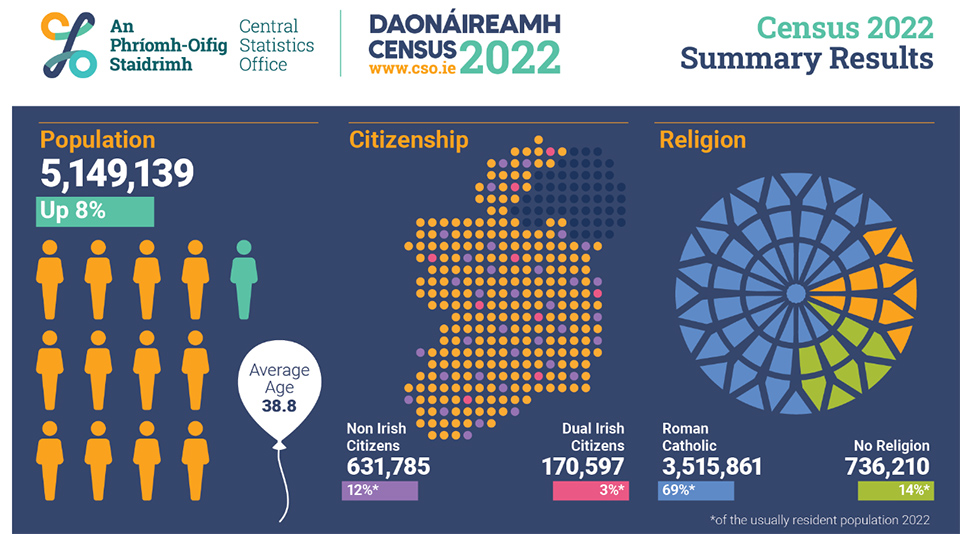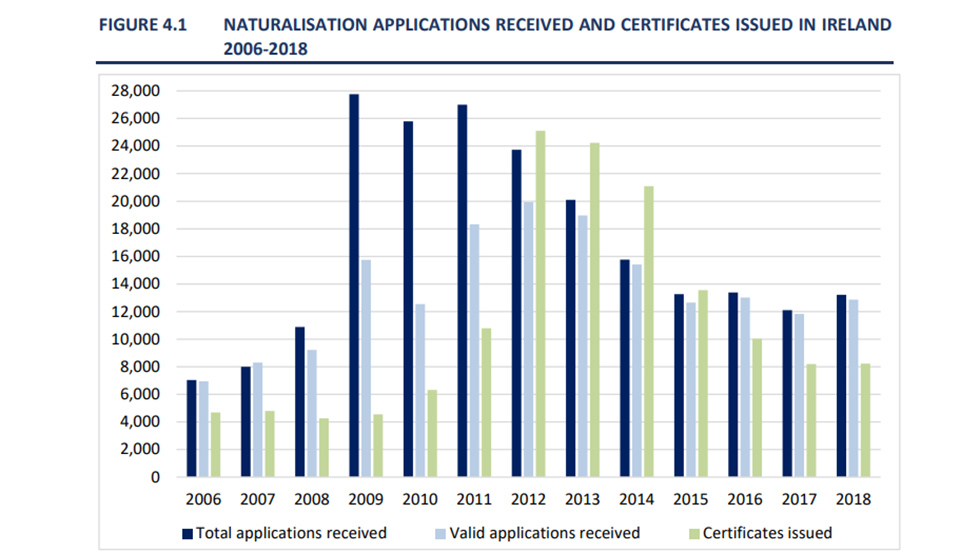When the changing demographics of the Irish state are discussed, “alarmist” references to the large and increasing proportion of people who were born overseas are sometimes dismissed by reference to citizenship.
The official soundbite from the findings of the Census taken in 2022 were that “just” 12% of the enumerated population of 5,149,139 who were usually resident in the state on April 3, 2022 were citizens of states other than the Irish state.

As Gript has pointed out, this grossly underestimated the numbers of people living in the state who were actually born overseas. That statistic was within the more detailed findings contained within the later releases from the Central Statistics Office.
This showed that the number of persons resident here but born overseas was now more than one million.
That was equal to 19.76% of the population – but this has now risen within 12 months to some 22% of our population born abroad. Even if we take the CSO’s estimate of the number of persons with other than Irish citizenship who were resident here one year after the Census we see significant growth.
In April 2023, just one year after the Census, the number of non-Irish citizens had risen to 757,000 – or 14.3% of the population of the state. That increase would indicate that somewhere in the region of 22% of the population of the state were born overseas.

The increase in that number, of 125,215 – within the space of one year – accounted for the almost entire population increase of 132,461 that was estimated by the CSO to have taken place between April 2022 and 2023. So the vast bulk of current population growth is accounted for by a mixture of non-nationals who are working or claiming asylum here.
In the meantime, the same official statistics show that more Irish citizens continue to leave the country than to return.
The discrepancy between persons of other than Irish citizenship or of dual Irish and other citizenship and the numbers of persons born overseas is largely accounted for by the number of persons of non-Irish birth who have been granted Irish citizenship.
While the regular citizenship ceremonies have become a feelgood media event, there has been little information to hand regarding the numbers who have been granted citizenship, their countries of origin or indeed of the conditions required to be granted citizenship by the Irish state.
Some light has been shed on this by a response last week to a Parliamentary Question from Rural Independent TD for Laois Offaly, Carol Nolan. Deputy Nolan had requested the figure for the numbers who had been granted citizenship, and for a breakdown of those figures on the basis of the nationality of those granted citizenship.
181,233 since 2010
In her response, the Minister for Justice, Helen McEntee, said that between the beginning of 2010 and including the latest conferrals for the first three months of 2024, a total of 181,233 persons had acquired Irish citizenship through naturalisation.
Over that period the main country of origin of people who have been granted citizenship has been Nigeria who accounted for a total of 24,094, more than 13% of the overall figure.
The other main countries of origin have been India, and the Philippines and the bulk of new citizens have been persons born outside of the EU and outside of Europe. This accounted for over 70% of the total conferrals in 2023.
In her response, Minister McEntee outlined the criteria for being granted citizenship through naturalisation in the Irish state: “Applicants are required to have 5 years reckonable residence in the State prior to making an application, except for spouses of Irish nationals and people granted International Protection where the requirement is 3 years. In all cases, the final 12 months must be continuous residence in the State with up to 70 days allowed to facilitate foreign travel for business family or holiday purposes.”
As has been pointed out previously, and as can be seen by a comparison with other states and in particular other stable democratic western democracies, acquiring Irish citizenship is remarkably easy by international standards.
According to the current criteria, a person could have spent four of the previous nine years prior to qualifying for citizenship living outside of the state.
This has led the World Population Review to include the Irish state as being among those in which it is easiest to apply for and to be granted citizenship. Right up there with Paraguay, Peru and St. Kitts and Nevis.
Nor are there any language tests nor tests of “loyalty” which would no doubt both be considered to be discriminatory and racist. It is hardly surprising then that the numbers applying have been steadily rising again as the macro-economic situation has improved.
The numbers granted citizenship peaked at over 25,000 in 2012 before falling to a low of 5,467 in 2020 during the Covid panic, but have risen steadily since and topped 18,000 in 2023.
Statistics contained in a report by the ESRI would also appear to indicate that the granting of citizenship as a proportion of applications has shifted radically towards what one must assume is a less stringent processing of such applications.
